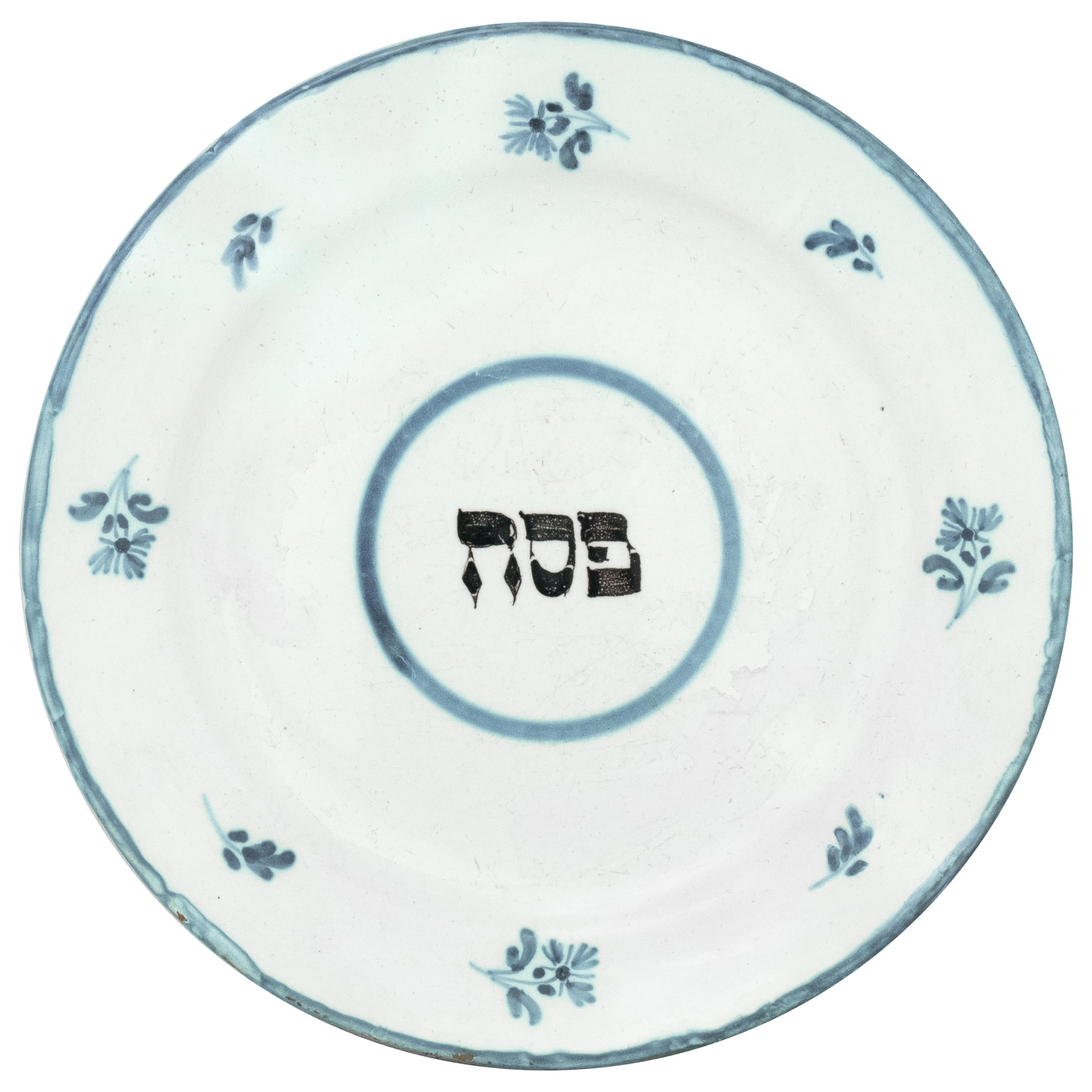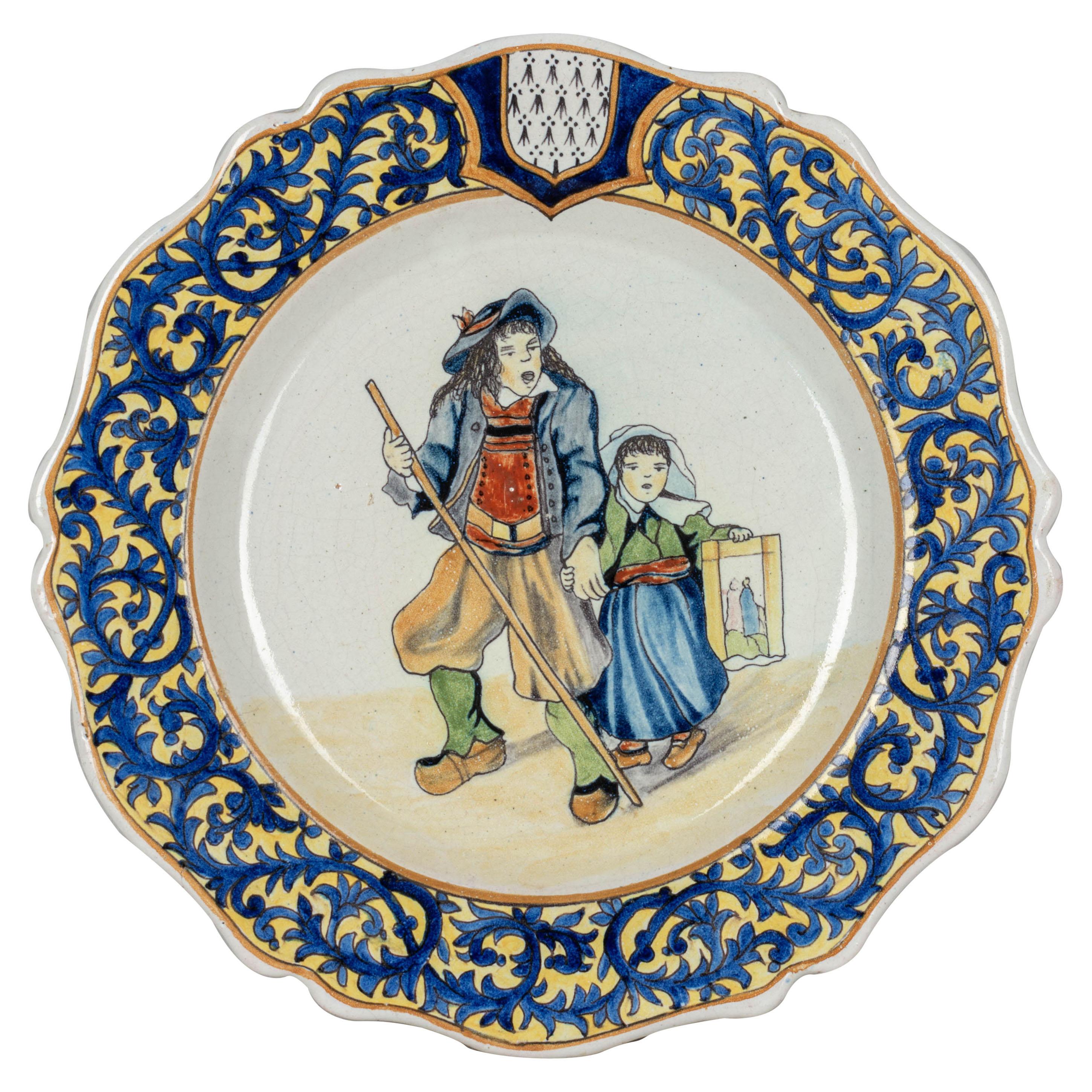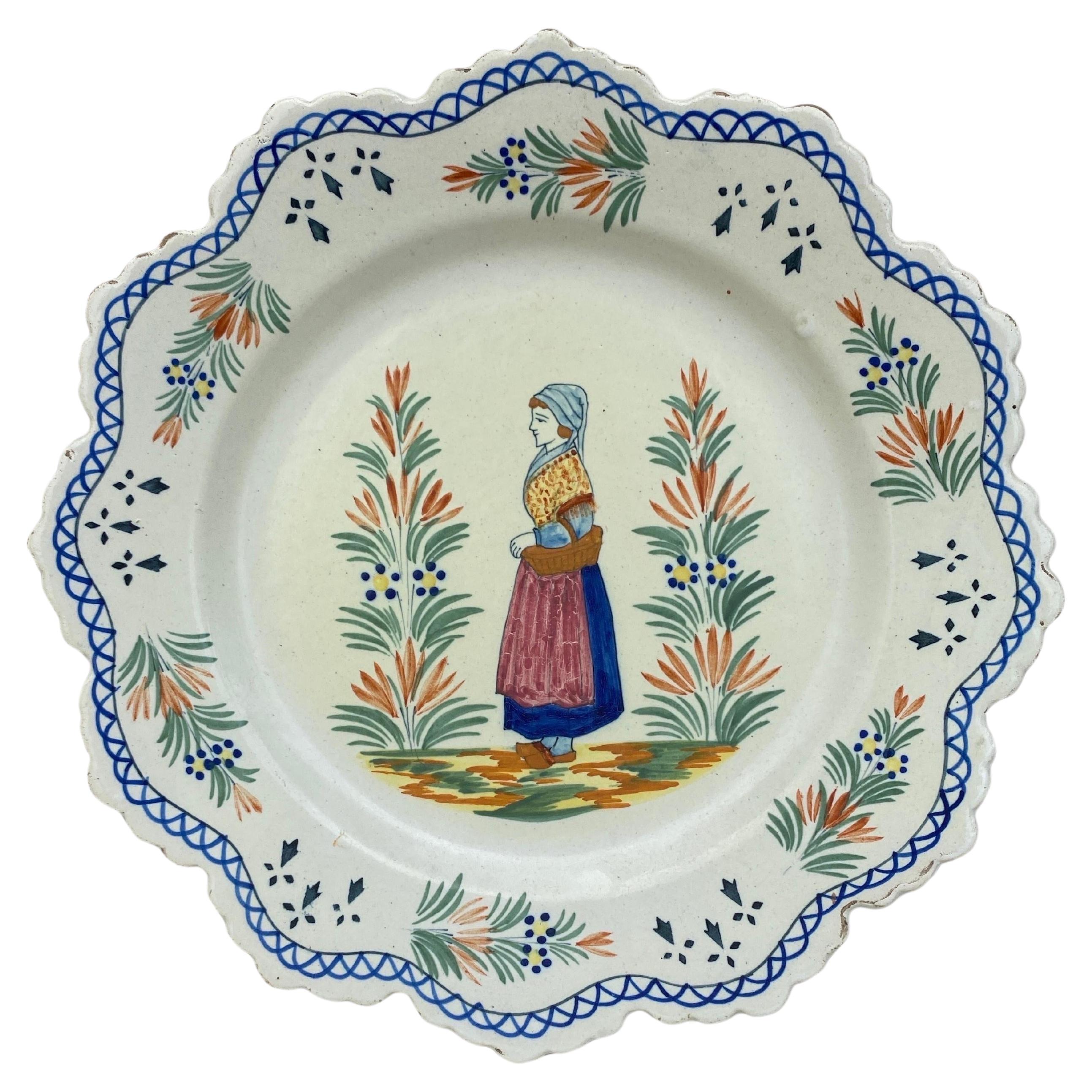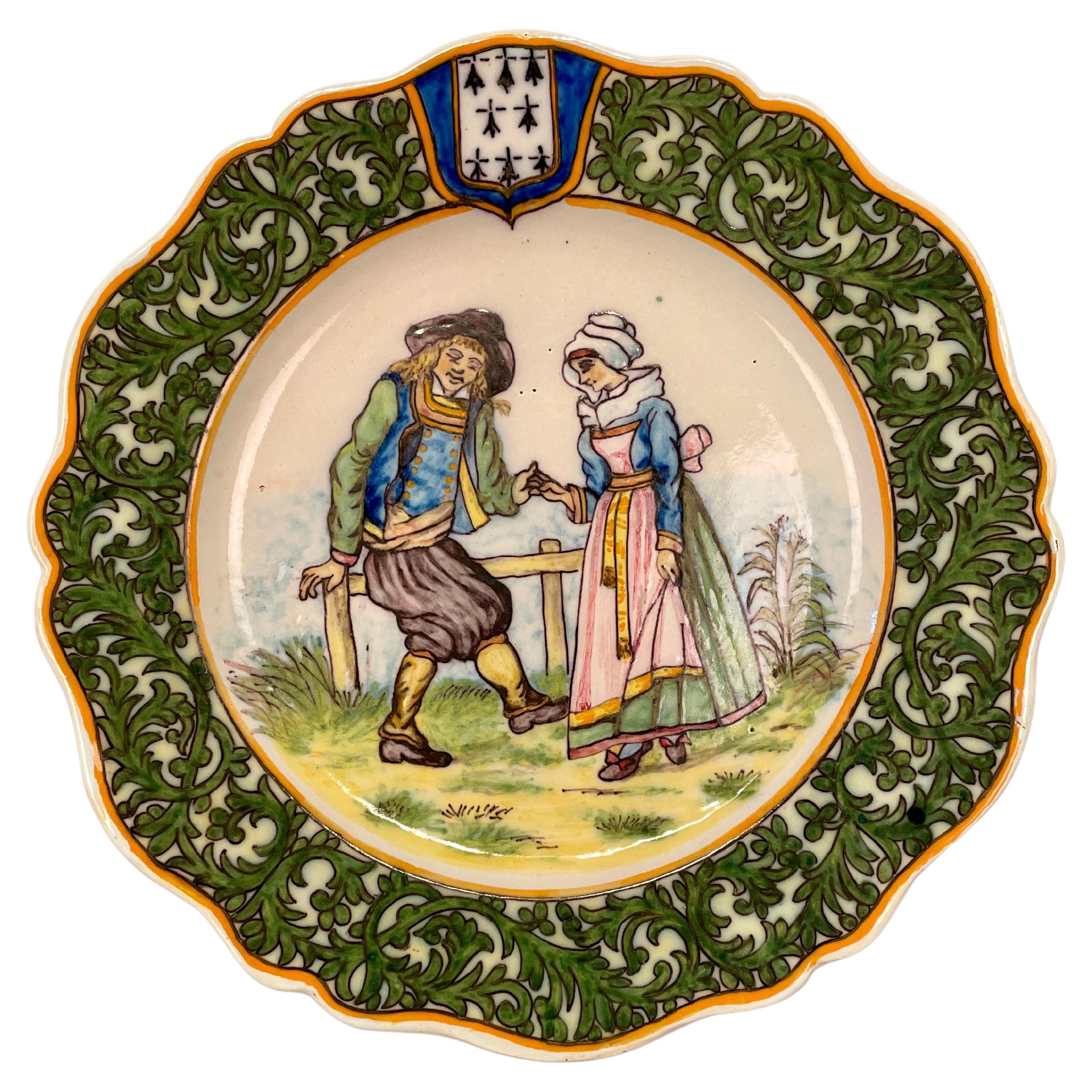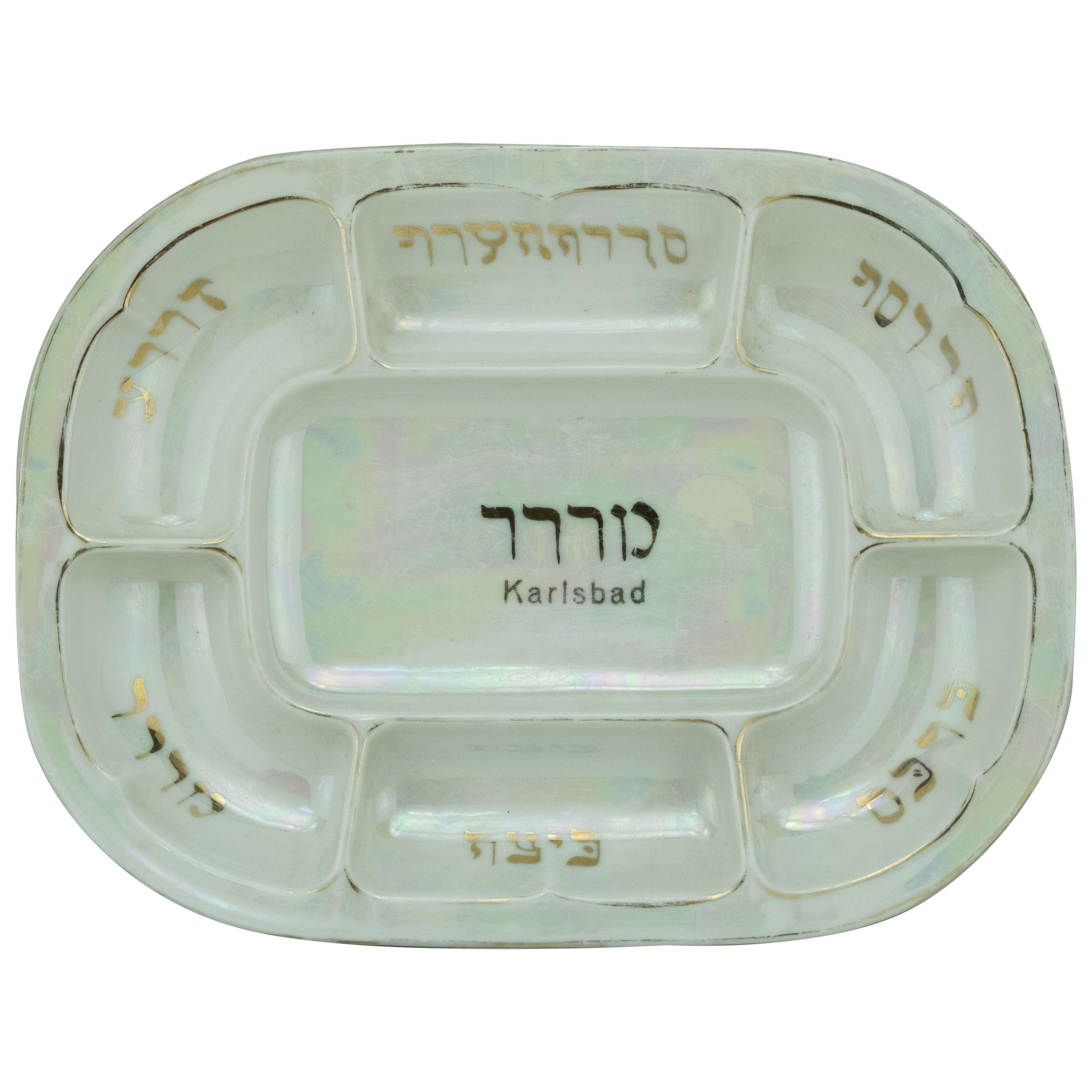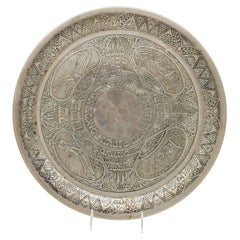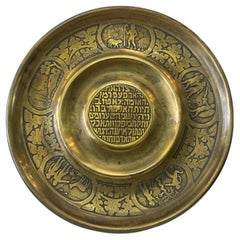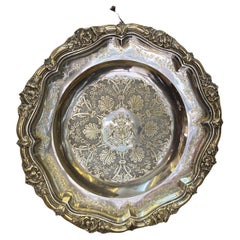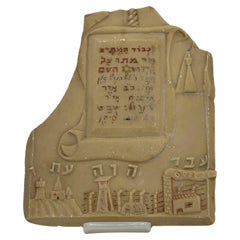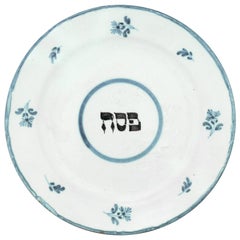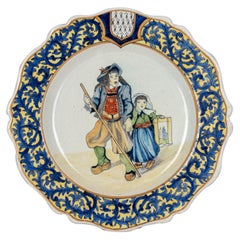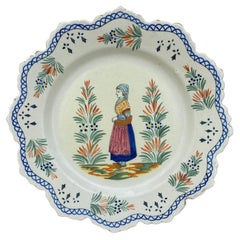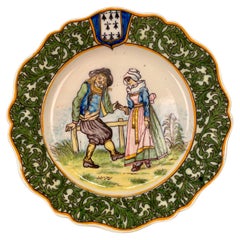Items Similar to French faience Passover plate, JUDAICA 19th century
Want more images or videos?
Request additional images or videos from the seller
1 of 7
French faience Passover plate, JUDAICA 19th century
$4,000
£3,020.43
€3,480.72
CA$5,645.70
A$6,224.26
CHF 3,256.33
MX$76,360.06
NOK 40,990.74
SEK 38,332.82
DKK 25,994.09
About the Item
this plate has a creme white background, the center painted with a man holding a lamb before a cityscape, probably a depiction of Jerusalem by someone who never actually visited the city or even see it, under the man there is the word Passover "פסח" the rim with the order of the Seder, and some grape vines between them.
Passover, also called Pesach ( Biblical Hebrew: חַג הַפֶּסַח, romanized: Ḥag haPesaḥ), is a major Jewish holiday, one of the three pilgrimage festivals, that celebrates the Biblical story of the Israelites' escape from slavery in Egypt.
Pesach starts on the 15th day of the Hebrew month of Nisan which is considered the first month of the Hebrew year. The Hebrew calendar is adjusted to align with the solar calendar in such a way that 15 Nisan always coincides with Sunday, Tuesday, Thursday, or Saturday. The Hebrew day starts and ends at sunset, so the holiday starts at sunset the day before. The word Pesach or Passover can also refer to the Korban Pesach, the paschal lamb that was offered when the Temple in Jerusalem stood; to the Passover Seder, the ritual meal on Passover night; or to the Feast of Unleavened Bread. One of the biblically ordained Three Pilgrimage Festivals, Passover is celebrated for seven days in Israel and for eight days among the Jewish diaspora, based on the concept of yom tov sheni shel galuyot. In the Bible, the seven-day holiday is known as Chag HaMatzot, the feast of unleavened bread (matzah).
According to the Book of Exodus, God (Yahweh) commanded Moses to tell the Israelites to mark a lamb's blood above their doors in order that the Angel of Death would pass over them (i.e., that they would not be touched by the tenth plague, death of the firstborn). After the death of the firstborn, Pharaoh ordered the Israelites to leave, taking whatever they want, and asked Moses to bless him in the name of the Lord. The passage goes on to state that the Passover sacrifice recalls the time when God "passed over the houses of the Israelites in Egypt".
This story is recounted at the Passover meal during the first two evenings of Passover by reading the Haggadah. The Haggadah is a standardized ritual account of the Exodus story, in fulfillment of the command "And thou shalt tell [Higgadata] thy son in that day, saying: It is because of that which the LORD did for me when I came forth out of Egypt
- Dimensions:Height: 1.6 in (4.07 cm)Diameter: 12.2 in (30.99 cm)
- Style:Victorian (Of the Period)
- Materials and Techniques:
- Place of Origin:
- Period:
- Date of Manufacture:1870
- Condition:perfect condition, some scratches and misfired spots on the plate from the firing process.
- Seller Location:Tel Aviv - Jaffa, IL
- Reference Number:1stDibs: LU8130238128812
About the Seller
No Reviews Yet
Vetted Professional Seller
Every seller passes strict standards for authenticity and reliability
1stDibs seller since 2023
- ShippingRetrieving quote...Shipping from: Tel Aviv - Jaffa, Israel
- Return Policy
Authenticity Guarantee
In the unlikely event there’s an issue with an item’s authenticity, contact us within 1 year for a full refund. DetailsMoney-Back Guarantee
If your item is not as described, is damaged in transit, or does not arrive, contact us within 7 days for a full refund. Details24-Hour Cancellation
You have a 24-hour grace period in which to reconsider your purchase, with no questions asked.Vetted Professional Sellers
Our world-class sellers must adhere to strict standards for service and quality, maintaining the integrity of our listings.Price-Match Guarantee
If you find that a seller listed the same item for a lower price elsewhere, we’ll match it.Trusted Global Delivery
Our best-in-class carrier network provides specialized shipping options worldwide, including custom delivery.More From This Seller
View AllDecorative Judaica Passover plate by Heinrich Schwed. Munich, 1924.
Located in Tel Aviv - Jaffa, IL
Decorative Passover plate by Heinrich Schwed. Munich, 1924.
ALPACA, etched.
This Large plate, featuring a round medallion in the center, with a Matzah which in this plate is hand c...
Category
Vintage 1920s Platters and Serveware
Materials
Alpaca
Rare early Bezalel Jerusalem JUDAICA etched brass garden of eden plate
Located in Tel Aviv - Jaffa, IL
very rare Bezalel Jerusalem plate , this amazing plate has the best subject And artistic Design i have seen in a lot of years, the plate has 5 different scenes from the story Of Adam And Eve in the garden pf Eden.
On the middle of the plate the is an Hebrew inscription, it is parts from the 5 lines that describe The 5 scene on the plate:
"וַיִּ֩יצֶר֩ אֶת־הָֽאָדָ֗ם עָפָר֙ מִן־הָ֣אֲדָמָ֔ה"
"And the Lord God formed man of dust from the ground"
"לֹא־ט֛וֹב הֱי֥וֹת הָֽאָדָ֖ם לְבַדּ֑וֹ"
"And the Lord God said, "It is not good that man is alone"
"'וַיִּֽהְי֤וּ שְׁנֵיהֶם֙ עֲרוּמִּ֔ים"
"Now they were both naked"
"וַתִּקַּ֥ח מִפִּרְי֖וֹ וַתֹּאכַ֑ל וַתִּתֵּ֧ן גַּם־לְאִישָׁ֛הּ"
"She took of its fruit, and she ate, and she gave also to her husband"
"וַיְגָ֖רֶשׁ אֶת־הָֽאָדָ֑ם וַיַּשְׁכֵּן֩ מִקֶּ֨דֶם לְגַן־עֵ֜דֶן אֶת־הַכְּרֻבִ֗ים וְאֵ֨ת לַ֤הַט הַחֶ֨רֶב֙ הַמִּתְהַפֶּ֔כֶת לִשְׁמֹ֕ר אֶת־דֶּ֖רֶךְ עֵ֥ץ הַֽחַיִּֽים:"
"And He drove the man out, and He stationed from the east of the Garden of Eden the cherubim and the blade of the revolving sword, to guard the way to the Tree of Life."
This rare plate is fully marked on the back "BEZALEL JERUSALEM" in Hebrew, the Jerusalem Mark is a bit worn but it is present, on the top of the mark there is the number 522 which is Probably the model number, this plate was mad on the early 1910s or even earlier and it is one of Bezalel earliest works, it is not known who is the artist but the artistic style is typical of Reuben Leaf Lipschitz, he was working in Bezalel in 1912-1916 and was the manager of the etching Department in this time frame, in 1916 he moved to the USA to escape joining the ottoman army in ww1. he stayed in the USA and became a graphic designer who designed and decorated Synagogues he also made graphic designs a illustrations to Hebrew books...
Category
Vintage 1910s Israeli Arts and Crafts Decorative Dishes and Vide-Poche
Materials
Brass
Important Rothschild family French silver presentation plate by Maurice Mayer
Located in Tel Aviv - Jaffa, IL
extremely rare french silver presentation plate/ dinner plate.
this important plate is one of the best quality work and engraving i have ever seen in my life, the outer rim is all adorned
and ornate with flowers in neoclassical style, and the actual plate is all hand engraved with the most incredible engraving with gold plating on just the engraved patterns what makes the plate looks like the gold plated part is 3 dimensional.
This important plate was made in paris by the famous silver master Maurice Mayer...
Category
Antique Late 19th Century French Neoclassical Sterling Silver
Materials
Gold Plate, Silver
Historic Rare Carved memorial plaque made by Jewish internee in Cyprus, 1948
Located in Tel Aviv - Jaffa, IL
super rare and historic example of Cyprus stone carving, made by jewish holocaust surviver that was Detained at the Internment camps in Cyprus, just 3 years after the holocaust. this piece is very unusual, most of this carvings shows us aspects of living in the Refugee camps or zionist views of israel, sometimes they even made judaica objects like menorahs Or Candlesticks, but its rare to find memorial plaques such as the example in front of us, the plaques was Damaged In the way to israel and two pieces from the upper section were broken off, the middle part of the Plaque shows a Scroll shaped memorial plaque with the inscription : "for the dead who died on the name of god" In red color, the middle has a yellow star carved and painted, just like the yellow star jewish...
Category
Vintage 1940s Cypriot Antiquities
Materials
Soapstone
Rare "Safed" kiddush cup, late 19th century Poland/ Eretz ISRAEL
Located in Tel Aviv - Jaffa, IL
This 84 silver cup was made in Europe, in Poland or parts of Poland that are in modern Russia in the 19th century, the interesting and important in this cup types is that they were s...
Category
Antique 1890s Israeli Sterling Silver
Materials
Silver
A RARE SILVER SHMIROT KIDDUSH CUP. Galician, c. 1850.
Located in Tel Aviv - Jaffa, IL
A RARE SILVER SHMIROT KIDDUSH CUP. Galician, c. 1850.
Among some Hassidic courts, it was a practice for the Rabbi to give a blessed silver coin to his Hassidim as an amulet. Such protection might be given for all manner of life events, from healing from an illness to success in travel and the amulet was carried on the body of the recipient. This custom was particularly popular among the Ryzhiner Hassidim and these coins were called "Shmirot". To such coins were attributed extraordinary power and value and they were treasured with great care and love.
this cup is marked with polish loth 12 mark which indicate silver content of 75%.
Size :
Height 2.3 inch / 6 cm
Width : 2 inch / 5 cm
After the specific event for which they had originally be given, such a coin or coins were used in the making of other objects, which maintained the special aura of the Rabbi. Such a coin would be melted in other silver with the amuletic valued being spread evenly to all the silver. Then a ritual object would be fashioned by a silversmith and the special nature of the item would be inscribed on it, indicating in one of several ways that this object had been made from "Shmirot". this objects include Kiddish cups, a Havdalah tray, a Shabbat salt holder, a Chanukkah Menorah, a Torah crown etc.
This object is a Kiddish cup fashioned from such silver. On this cup, the inscription indicating Shmirot is found in the abbreviation of the words "made from shmirot k (kodesh)' " (This is the cup of Shmirot). Such cups were used for blessing the wine so that each use renewed the power of protection granted by the Rabbi. This cup was used for the blessing over wine on Shabbat and holidays. Inscription:
the other iconography on the cup is of a lion that represent Through the tribe of Judah, the lion symbol came to represent the blessing, majesty, and even divine protection of the Jews. The lion symbol continued to be used even after the destruction of Jerusalem, the capital of Judah's nation,
and a unicorn or a re'em, also reëm (Hebrew: רְאֵם), is an animal mentioned nine times in the Hebrew Bible It has been translated as "unicorn" in the Latin Vulgate, King James Version, and in some Christian Bible translations as "oryx" (which was accepted as the referent in Modern Hebrew),[citation needed] "wild ox", "wild bull", "buffalo" or "rhinoceros". Rabbi Natan Slifkin has argued that the re'em was an aurochs, as has Isaac Asimov...
Category
Antique 1850s Sterling Silver
Materials
Silver
You May Also Like
Early 18th Century Dutch Tin-Glazed Earthenware Passover Plate
Located in New York, NY
18th century tin-glazed earthenware Passover plate, Delft, the Netherlands.
Decorated with a foliate design in light blue, the Hebrew word "Pesach" (Pas...
Category
Antique Early 18th Century Dutch Religious Items
Materials
Earthenware
$1,910 Sale Price
20% Off
19th Century French Malicorne Faience Plate
By Beatrix Pouplard
Located in Winter Park, FL
A late 19th century French Malicorne faience pate, hand painted with Breton man and child in traditional costume and decorative blue and yellow border on the rim. Nice quality, thick...
Category
Antique 19th Century French Country Delft and Faience
Materials
Faience
French Rustic Faience Plate Circa 1900
Located in Austin, TX
French Rustic Faience Plate Circa 1900.
Signed PB Auvergne.
Category
Antique Early 1900s French French Provincial Dinner Plates
Materials
Faience
19th Century French Porquier Beau Faience Plate
Located in Winter Park, FL
A good 19th century French Porquier Beau Quimper Plate with a dark green border depicting a courting scene. Good details and in no chips nor hairline.
S...
Category
Antique Late 19th Century Delft and Faience
Materials
Faience
Rare European 19C Judaica Havdalah Hebrew Plate
Located in Surfside, FL
Here is a rare late 19th Century-early 20th Century painted and stenciled Jewish plate with a Yiddish greeting. A rare piece of Jewish Porcelain from the...
Category
Late 19th Century Folk Art More Art
Materials
Porcelain
Early 20th Century Czech Porcelain Passover Seder Plate
Located in New York, NY
Unusual oval shape Seder plate, Karlsbad, Czechoslovakia, circa 1900.
Divided into seven wells and inscribed with gold lettering and border with the order of the Seder.
Signed on t...
Category
Early 20th Century Czech Porcelain
Materials
Porcelain
$660 Sale Price
38% Off
More Ways To Browse
Antique Judaica Silver
Temple Jerusalem
Passover Seder Plate
Passover Silver
Postmodern Trays
Vintage Gold Tray
Wallace Silver Plate Trays
Antique Bread Tray
Fb Rogers
Georgian Pewter
Majolica Cake
Majolica Service
Reed Barton Tray
Silver Butlers Platter
Silver Tray Feet
Staffordshire Blue Platter
Vintage Ceramic Turkey Platter
Vintage Frying Pans
